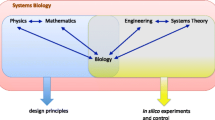Abstract
This paper contrasts and compares strategies of model-building in condensed matter physics and biology, with respect to their alleged unequal susceptibility to trade-offs between different theoretical desiderata. It challenges the view, often expressed in the philosophical literature on trade-offs in population biology, that the existence of systematic trade-offs is a feature that is specific to biological models, since unlike physics, biology studies evolved systems that exhibit considerable natural variability. By contrast, I argue that the development of ever more sophisticated experimental, theoretical, and computational methods in physics is beginning to erode this contrast, since condensed matter physics is now in a position to measure, describe, model, and manipulate sample-specific features of individual systems—for example at the mesoscopic level—in a way that accounts for their contingency and heterogeneity. Model-building in certain areas of physics thus turns out to be more akin to modeling in biology than has been supposed and, indeed, has traditionally been the case.
Similar content being viewed by others
References
Bailer-Jones D. (2002) Scientists’ thought on scientific models. Perspectives on Science 10: 275–301
Batterman R. (2002) Asymptotics and the role of minimal models. British Journal for the Philosophy of Science 53: 21–38
Bronfenbrenner M. (1966) A middlebrow introduction to economic methodology. In: Sherman R. K. (ed) The structure of economic science: Essays on methodology. Prentice-Hall, Englewood Cliffs, pp 4–24
Cartwright N. (1983) How the laws of physics lie. Oxford University Press, Oxford
Cartwright N. (1999) Models and the limits of theory: Quantum Hamiltonians and the BCS model of superconductivity. In: Morgan M.S., Morrison M. (eds) Models as mediators: Perspectives on natural and social science. Cambridge University Press, Cambridge, pp 241–281
French S., Ladyman J. (1997) Superconductivity and structures: Revisiting the London account. Studies in History and Philosophy of Modern Physics 28: 363–393
Gelfert A. (2009) Rigorous results, cross-model justification, and the transfer of empirical warrant: The case of many-body models in physics. Synthese 169: 497–519
Gelfert A. (2011) Mathematical formalisms in scientific practice: From denotation to model-based representation. Studies in History and Philosophy of Science 42: 272–286
Goldenfeld N. (1992) Lectures on phase transitions and the renormaliztion group. Boulder Westview Press, Oxford
Hamilton A. (2007) Laws of biology, laws of nature: Problems and (Dis)solutions. Philosophy Compass 2: 592–610
Imry Y. (2008) Introduction to mesoscopic physics (2nd ed.). Oxford University Press, Oxford
Justus J. (2005) Qualitative scientific modeling and loop analysis. Philosophy of Science 72 (Proceedings): 1272–1286
Keller E. F. (2002) Making sense of life: Explaining biological development with models, metaphors, and machines. Harvard University Press, Cambridge
Krieger M. (1981) Phenomenological and many-body models in natural science and social research. Fundamenta Scientiae 2: 425–431
Lansbergen, G., et al. (2008). Transport-based dopant metrology in advanced FinFETs. IEEE IEDM 2008. Retrieved May 02, 2010, from Purdue e-Pubs http://docs.lib.purdue.edu/nanodocs/153.
Lee P. A., Stone A. D., Fukuyama H. (1987) Universal conductance fluctuations in metals: Effects of finite temperature, interactions, and magnetic field. Physical Review B 35(3): 1039–1070
Leggett A. J. (2006) What do we know about high T c ?. Nature Physics 2: 134–136
Levins R. (1966) The strategy of model building in population biology. American Scientist 54: 421–431
Matthewson J. (2011) Trade-offs in model building: A more target-oriented approach. Studies in History and Philosophy of Science 42: 324–333
Matthewson J., Weisberg M. (2009) The structure of tradeoffs in model building. Synthese 170: 169–190
Niss M. (2009) History of the Lenz–Ising model 1950–1965: From irrelevance to relevance. Archive for History of Exact Sciences 63: 243–287
Odenbaugh J. (2003) Complex systems,trade-offs,and theoretical population biology: Richard Levins’s “Strategy of Model Building in Population Biology” Revisted. Philosophy of Science 70: 1496–1507
Orzack S. H., Sober E. (1993) A critical assessment of Levins’s ‘The strategy of model building in population biology’ (1966). Quarterly Review of Biology 68: 533–546
Rowbottom D. P. (2009) Models in biology and physics: What’s the difference?. Foundations of Science 14: 281–294
Rueger A., Sharp W. D. (1996) Simple theories of a messy world: Truth and explanatory power in nonlinear dynamics. British Journal for the Philosophy of Science 47: 93–112
Suárez M., Cartwright N. (2008) Theories: Tools versus models. Studies in History and Philosophy of Modern Physics 39: 62–81
Weisberg M. (2004) Qualitative theory and chemical explanation. Philosophy of Science 71: 1071–1081
Wong J., Peter G., Dumas R. K., Kai L. (2009) Probing magnetic configurations in Co/Cu multilayered nanowires. Applied Physics Letters 94: 032504
Yi S.-W. (2002) The nature of model-based understanding in condensed matter physics. Mind and Society 3: 81–91
Author information
Authors and Affiliations
Corresponding author
Rights and permissions
About this article
Cite this article
Gelfert, A. Strategies of model-building in condensed matter physics: trade-offs as a demarcation criterion between physics and biology?. Synthese 190, 253–272 (2013). https://doi.org/10.1007/s11229-012-0145-4
Received:
Accepted:
Published:
Issue Date:
DOI: https://doi.org/10.1007/s11229-012-0145-4




